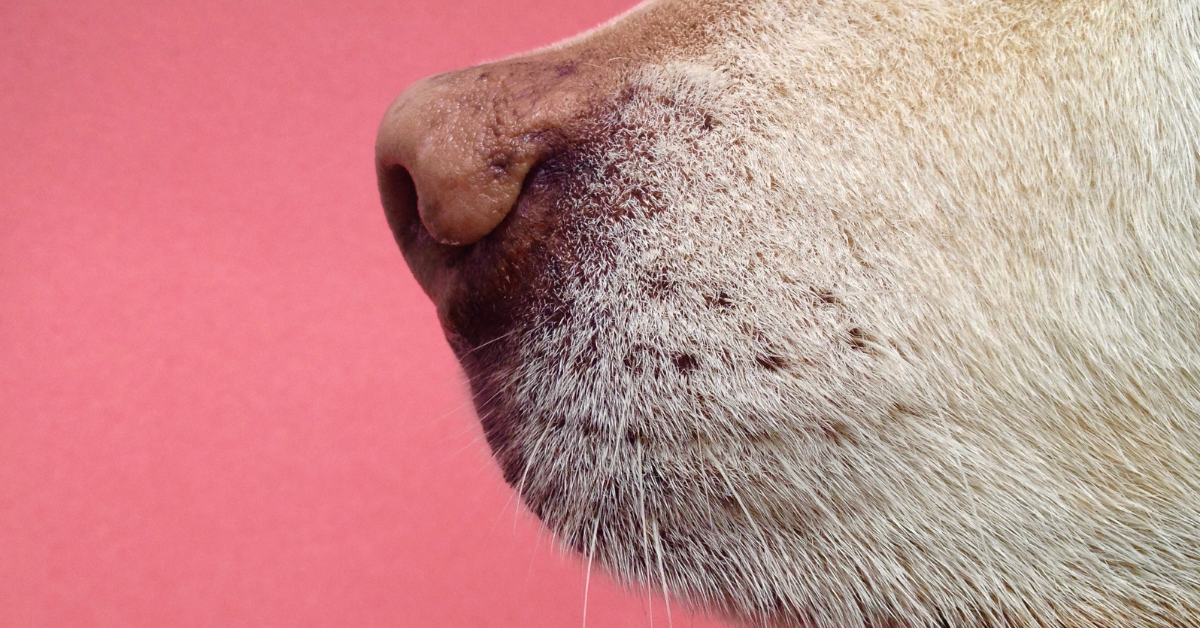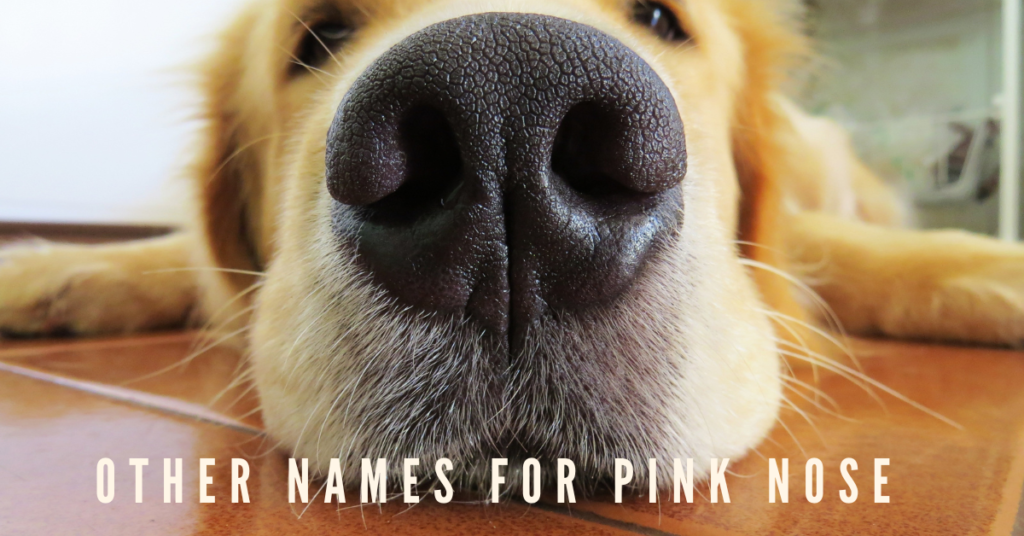


have you ever seen a pink nose in dogs? A black button-like nose is the trademark of every doggo on the planet. However, there are times when you observe a massive color change from black to pink. the color change is most obvious in the summer season thus raising concern in dog owners. Here we will discuss the reasons behind this changing color and what can you do about it.
Why do dogs have pink noses?
Most dogs when born have pink noses but when the dogs grow old, their noses turn black. The reason behind dark noses is the high quantity of melanin that turns the tip of the noses black. The change in color is because of exposure to sunlight daily. However, keep in mind that some dogs have a naturally pink nose that remains the same for the rest of life. On the other hand, some canines might have an illness that causes a visible change in nose color.
Breeds that might be susceptible to pink noses:

While no specific breed is universally susceptible to pink noses, certain dog breeds are more prone to developing this condition. Some breeds that may be more susceptible to pink noses include:
Dalmatian:
Dalmatians are known for their unique coat pattern and can often have pink or partially pink noses. This is due to a condition called “nose depigmentation” or “nose snow.”
Golden Retriever:
Some Golden Retrievers may experience a condition called “snow nose,” where their noses turn pink or lighter in color during winter. However, their noses typically return to their normal pigment during other seasons.
Siberian Husky:
Siberian Huskies can have noses that change color seasonally, with pink or lighter noses in the winter and darker noses during the rest of the year.
Labrador Retriever:
Although Labradors typically have black noses, some individuals may have a condition called “Dudley nose” where their noses are pink or lighter in color.
It’s important to note that nose color variations can occur in any breed and are not necessarily indicative of a health issue. However, if you notice any changes in your dog’s nose color, it’s always a good idea to consult with a veterinarian to rule out any underlying concerns.
What are other names for pink noses?

The pink nose is also known under different names. Here are some common names referring to pink noses in dogs:
- Snow nose.
- Dudley nose.
- Dilute.
- Flesh-colored nose.
- Rose-colored nose.
- Fleshy nose
Reasons behind pink noses.

There can be many reasons behind the pink noses of dogs. here are a few known reasons:
Genetic factors:
Some dogs carry pink nose genes that show u in each generation. some breeds may carry genes that result in reduced pigmentation or variations in nose color. These genetic variations can lead to pink or partially pink noses. Breeds like Dalmatians are known for their distinctive coat pattern, which often includes pink or partially pink noses due to a genetic condition called “nose depigmentation.”
Seasonal changes:
Some dogs experience a phenomenon known as ‘snow nose’ or ‘winter nose’. When older month approaches the nose of certain breeds turn pink. Examples of these breeds are Golden Retrievers and Siberian Huskies. The color change is temporary. This change is thought to be triggered by a decrease in sunlight exposure. As the seasons change and sunlight exposure increases, their noses usually return to their normal pigment.
Sun Exposure:
If your dog has gone through prolonged sun exposure, its nose might get pink or light in color. This is more commonly seen in dogs with lighter or less pigmented noses. Dogs can experience sunburn just like human beings. Moreover, your doggo may also experience subsequent inflammation and damage to the nose can result in changes in nose color. Protecting your dog’s nose from excessive sun exposure is important by providing shade and using pet-safe sunscreen if necessary.
Age:
As the dog ages, the nose color starts changing. In fact, some dogs develop a pinkish or lighter nose as they get older. This change is typically a natural part of the ageing process and is not usually a cause for concern.
Health conditions:
While most cases of pink noses are benign, in some instances, changes in nose color can be associated with underlying health conditions. For example, certain autoimmune disorders can lead to depigmentation of the nose. If you notice any other concerning symptoms or if the change in nose color is accompanied by other health issues, it’s advisable to consult with a veterinarian for a proper evaluation. Besides that, also check for stress levels in dogs.
When should you be concerned?

You should be concerned about your dog’s pink nose if:
Sudden Change:
If your dog’s nose color has suddenly changed from its normal pigment to pink, especially if it occurs rapidly or is accompanied by other unusual symptoms, it’s important to consult with a veterinarian. Sudden and unexplained changes in nose color can sometimes indicate an underlying health issue that requires medical attention.
Persistent Pinkness:
If your dog’s nose remains pink for an extended period without any signs of returning to its normal color, it’s advisable to seek veterinary advice. Prolonged pinkness that persists beyond seasonal or temporary changes may warrant further investigation.
Other Symptoms:
If your dog displays additional concerning symptoms alongside the pink nose, such as nasal discharge, crustiness, swelling, bleeding, or changes in behavior or appetite, it’s essential to consult a veterinarian promptly. These signs may indicate an underlying health condition that requires professional evaluation and treatment.
Discomfort or Pain:
If your dog appears to be experiencing discomfort, pain, or sensitivity around the pink nose, it’s crucial to have a veterinarian assess the situation. Dogs may exhibit signs of discomfort by pawing at their noses, rubbing them against surfaces, or avoiding contact in that area.
How to care for pink noses

Caring for pink noses in dogs involves taking certain measures to protect sensitive skin and promote overall nose health. Here are some tips on how to care for pink noses:
Sun Protection:
Since pink noses are often more susceptible to sunburn, it’s important to protect them from excessive sun exposure. Limit your dog’s time in direct sunlight, especially during peak hours when the sun’s rays are strongest. Provide shade or use accessories like doggy hats or sun shirts to shield the nose from harmful UV rays. Additionally, consider applying a pet-safe sunscreen specifically formulated for dogs to the nose area before going outside.
Moisturization:
Pink noses can be prone to dryness and cracking. To keep the nose moisturized, you can apply a thin layer of a pet-safe, unscented moisturizing balm or petroleum jelly. This can help prevent dryness and maintain the skin’s barrier function. However, it’s essential to use products specifically designed for dogs and avoid any human skincare products that may contain ingredients harmful to pets.
Protection from Harsh Elements:
Extreme weather conditions, such as cold winds or excessive heat, can further irritate and dry out pink noses. Protect your dog’s pink spot in nose by providing adequate shelter during extreme weather conditions. In cold weather, consider using a doggy nose balm or covering the nose with a warm cloth or dog-friendly balaclava to shield it from the cold air.
Regular Veterinary Check-ups for pink nose in dog:
Routine veterinary check-ups are important to monitor your dog’s overall health, including their nose. During these visits, the veterinarian can examine the nose, address any concerns, and provide guidance on specific care based on your dog’s individual needs.
Proper Nutrition:
A balanced and nutritious diet plays a crucial role in maintaining overall skin health, including the nose. Ensure your dog’s diet includes essential nutrients, vitamins, and antioxidants that promote skin health. Consult with your veterinarian to determine the most suitable diet for your dog’s specific needs. This way you will prevent the dog’s nose turning pink in summer.
FAQ:
Why is my dogs nose turning pink in summer?
It can be due to prolonged exposure to sunlight. If your dog remains outside during peak summer season, chances are its nose will start changing color. In other words, it can also be an indication of sunburn.
Do dogs’ noses turn pink in winter?
Yes, it is possible for a dog’s nose to turn pink or lighter in color during the winter months. In some dog breeds, especially those with lighter-colored fur, the nose may lose some pigmentation and appear pink or pale. This is more noticeable in colder weather when the dog’s nose is exposed to lower temperatures and less sunlight.
Conclusion:
In conclusion, dogs can have pink noses due to a variety of reasons, including genetics, breed characteristics, and environmental factors. The lack of pigmentation in the nose leads to a lighter color, which may appear pink. While pink noses are generally harmless and do not cause any health issues, it’s important to be mindful of their vulnerability to sunburn and dryness

